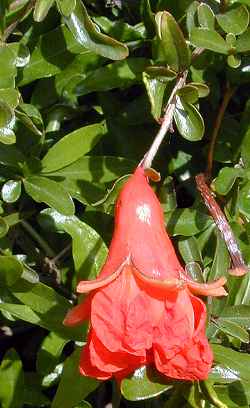Sunset®: 5-31
USDA: 7b-10
Frost Tolerance: Hardy in Phoenix to 5° F (-15° C)
Sun Exposure: Full sun to light shade
Origin: North Africa
Growth Habits: Tree 15 to 20 feet high (4.5 to 6 m), but can be kept trimmed as a bush 6 to 12 feet (1.8 to 3.6 m)
Flowers: Light orange or red flowers
Watering Needs: Little water once established, but water deeply and regularly for good fruit production (in Phoenix, SRP irrigation is perfect).
Propagation: Seeds, cuttings, or layer
Propagation: Cutting or occasionally seed
- by semi-hardwood secondary cuttings, in summer. Use intermittent mist. Root in 6-8 weeks.
- by seeds.

Punica 'Tayosho'
The Pomegranate originated in southern Asia but is now common throughout the tropics and subtropics. It was well known in the Mediterranean region in early historical times and seems well adapted to the semiarid parts of that area.

"Granada, pomegranate, Punica granatum L.", 19797 U.S.D.A. Forest Service., Courtesy of the Hunt Institute
Blooming Habits:
For most fruiting varieties, large orange-red flowers are produced in April, but some varieties are more or less everblooming. Ornamental yellow or white flowered varieties are sometimes seen. If you are interested in the fruits, avoid the miniature or double flowered varieties, since they either produce few or small fruits.
Fruiting Habits:
The leathery skinned, attractive, red or yellow fruit vary in size from 2 to 5 inches. They are nearly globular with the notched, tubular calyx persisting. The cavity is filled with numerous seeds, each enclosed in its pink, transparent, juice sac. This juicy pulp is the edible portion of the fruit. It may be eaten out of hand or made into a cooling drink by the addition of sugar and water. This is the original "grenadine".
The ripening season extends from midsummer to late fall. Many varieties of the pomegranate are known:
Chico: Dwarf, double orange red flowersalmost everblooming, but no fruit.
Nana: Dwarf (up to 18 inches - 45 cm), attractive in windows, or as bonsai, red flowers, edible 1.5 inches fruit (4 cm).
Wonderful: The most common fruiting variety, works well in Phoenix, red blossom in April are followed by 4 inch (10 cm) fruit ripening in the fall.
Culture:
If unpruned the pomegranate develops into a tree 15 to 20 feet in height, but it is easily kept to a bush of 6 to 12 feet. In the cooler parts of its range, the plants are deciduous. The 2- to 4- inch, undulating, shining green leaves are tapered at both ends.
Propagation:
Propagation is by seeds, stem cuttings in summer, hardwood cuttings in winter, or layers.
It is easy to press the seed out of the pulp, but chances are that that the seedling will be of inferior quality. Harwood cuttings are relatively easy, take cuttings in December, and bury them in sand or soil leaving just the top 2 buds out. They should grow in the spring. Layering and grafting are also used. Grafting uses pomegranate seedling rootstock. Birds enjoy the pomagranate fruits, and the seeds are not digested, so you can expect seedlings to come out a little bit everywhere in the proximity of a fruit-producing pomegranate tree.
Desert-Tropicals is dedicated to provide gardening advice, gardening ideas, and information about flower of all kind for landscape and collections.We try to check carefully the identification of the plants on the illustrations as well as the other information from the page, but occasionally errors do occur. if you notice anything that needs to be changed please contact us.Thanks.
© 1998-2020 Philippe Faucon, All Rights Reserved.
